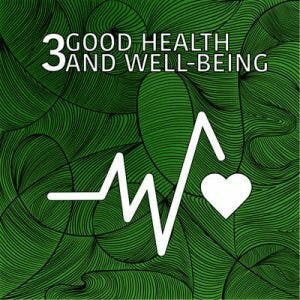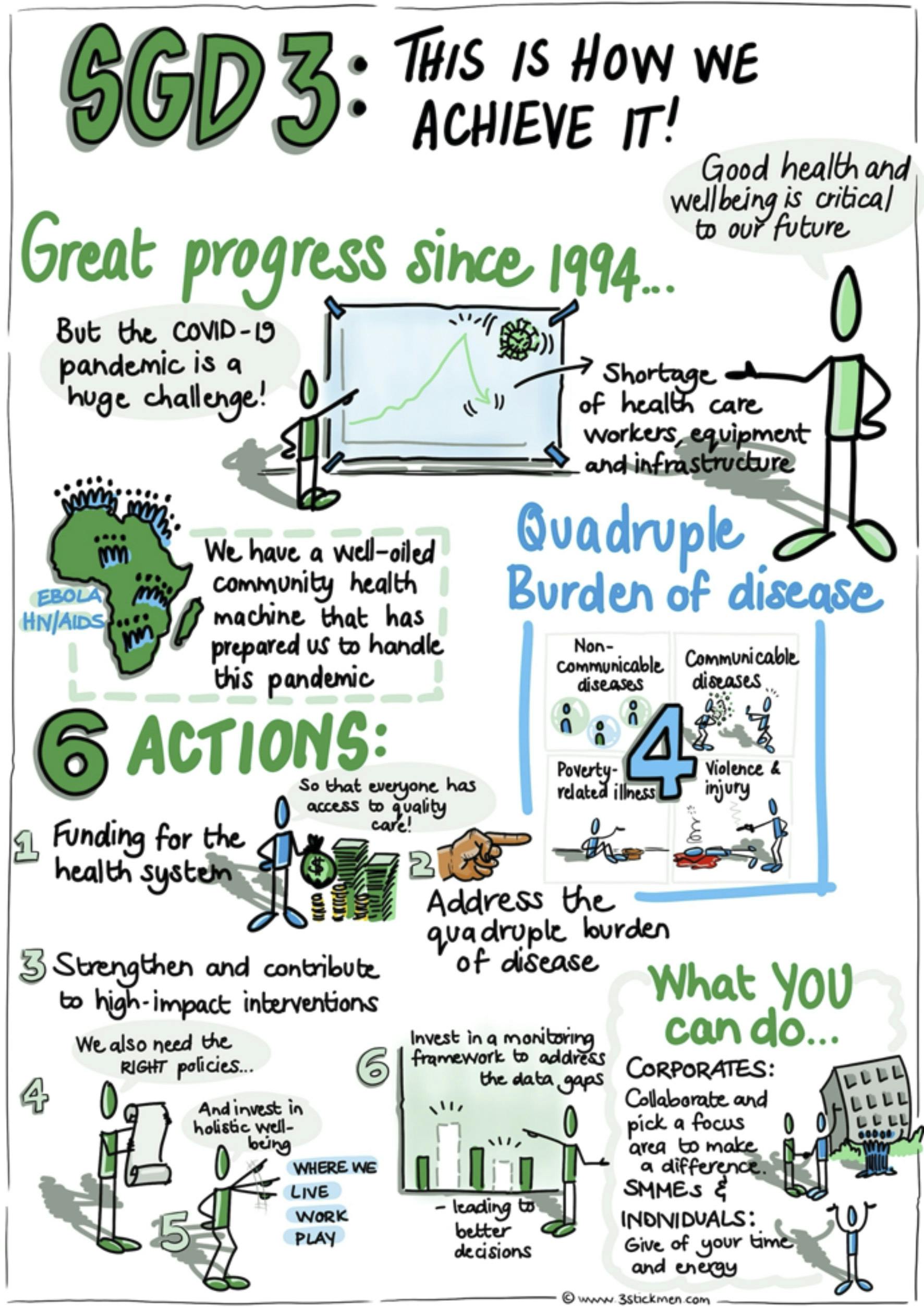SDG 3: Ensure healthy lives and promote wellbeing for all at all ages
The objective of SDG 3 is to ‘Ensure healthy lives and promote well-being for all at all ages’. Without good health, it is impossible to function at our full potential. Our physical health and mental well-being determine the quality of life we can live and influence the health and mental well-being of those we come into contact with each day. South Africa’s economic performance and social progress are dependent on the health and well-being of its people.
As this is a complex SDG, we have chosen to keep our introductory article simple. We will share 12 tips to explain each SDG 3 target in detail and provide practical examples of how you can get involved in making them happen.
The three key questions
Now let us answer the three key questions.
Where is South Africa on its journey towards achieving SDG 3?
Dr Flavia Senkubuge − a specialist in public health medicine, president of the Colleges of Medicines of South Africa, chair of the WHO African Advisory Council on Research and Development, and vice-president of the African Federation of Public Health Associations − provided us with the following overview of South Africa’s status on achieving SDG 3:
- South Africa has made progress in line with the SDG 3 targets and indicators since 1994, but still has work to do to realise a number of the targets. Although the health system is still inequitable, progress is being made towards universal health coverage (UHC) with the introduction of National Health Insurance (NHI).
- There is evidence that South Africa is making some progress in improving health outcomes, as demonstrated by trends in key health indicators towards the end of the Millennium Development Goal (MDG) era, together with those in the SDG 3 baseline report. The health systems and socio-economic factors responsible for the progress in health indicators observed in the MDG era remain in place and should continue to positively impact on the trends in the SDG era, but so do the factors impeding accelerated progress that will put the country firmly on the path of attainment of the Health SDGs. The country needs to identify and strengthen its implementation of key interventions that have been demonstrated globally to have the most impact on health outcomes into the local context.
The Sustainable Development Goals Country Report 2019 − South Africa provides us with the following summary of South Africa’s progress towards achieving SDG 3: ‘South Africa has made notable progress in reducing the maternal mortality ratio, the under-5 mortality rate, neonatal mortality rate and the infant mortality rate. New HIV infections have also slowed down, and the incidence of tuberculosis has declined. Despite significant progress, the incidence of HIV and tuberculosis remains very high. South Africa is seeing an increase in the harmful use of alcohol.’1
It should be noted that SDG 3 has been one of the ‘hardest hit’ by COVID-192 (which occurred after the 2019 SDG Country Report was published). Through the pandemic’s urgent requirement for facilities, equipment and medication, certain resources have been taken away from other disease prevention and management programmes that were already stretched, such as those for malaria, HIV/AIDS and tuberculosis. COVID-19 has also caused a rise in mental health problems and because we are experiencing a greater resource shortage, these problems have not been receiving all the help and treatment they so desperately require.3
What are the major challenges?
Dr Senkubuge provides us with the following insights on the major challenges:
‘Before the current pandemic I would have said that similar to most low- and middle-income countries, data gaps exist that need to be filled through the strengthening of routine health information systems, surveillance systems and targeted research. With data availability, it will be possible to explore underlying inequities through disaggregation of the data.’
‘But now with the COVID-19 pandemic, the first challenge in achieving SDG 3 is tackling COVID-19 because we need to take great care that the gains that we have made are not rolled back. Then we need to focus on improving investment in health and overcoming the data gaps.’
These valuable insights are supported and expanded on by the findings reflected in the 2019 South Africa Voluntary National Review4 which states that South Africa’s key challenges include:
- Increasing funding
- Improving access to healthcare (particularly in poor areas)
- Getting better value for money by strengthening procurement practices (for example for medicines, vaccines and medical equipment), and
- Improving mental health and disability services
How can you get involved?There is an important role each one of us can play and whatever the size of your contribution may be, it is necessary.
When we asked Dr Senkubuge which three key areas we can focus on, she pointed out that there are in fact six key areas. These are:
- Fund the health system and implement National Health Insurance (NHI)
- Address the burden of disease
- Strengthen high-impact interventions at a health programme level
- Evaluate the impact of the choice of policies implemented for the Millennium Development Goals (MDGs) to provide guidance on target-specific policies to implement for the SDGs
- Invest in the social determinants of health (including investing in well-being programmes), and
- Implement a National SDG Monitoring Framework in South Africa to address the data gaps.
The National Business Initiative (NBI) provides two summary slides on SDG 3 which are a good starting point for understanding how to develop a National SDG Monitoring Framework for South Africa. These can be found here.5
If you are part of a large organisation, Dr Senkubuge says you could assist by helping your organisation partner with government, other organisations and individuals to work together to achieve a specific SDG 3 target such as reducing non-communicable diseases, communicable diseases, or maternal and childhood deaths. Your organisation could also help by providing funding to support this work. We need to work together to ensure that as much as we are faced with COVID-19 right now, the gains South Africa has already made from existing health programmes are sustained and leveraged.
Large organisations have been built by establishing remarkable networks and value chains through the work of their people. As such, they have a significant impact on the health and well-being of both their people and their supporting communities. They can make a fundamental difference to the status of South Africa’s health and well-being by using these networks and value chains along with their communications strength, employee health and well-being programmes and CSI spend to help South Africa achieve this important SDG.
A case study published in September 2019 titled Private sector contribution to SDG 3: Health and well-being − a South African case study provides further support for the above recommendations.6
If you are part of an SMME or want to make an individual contribution, Dr Senkubuge says being part of the dialogue and conversation about the SDGs (especially SDG 3) is a good starting point. Then invest your time and energy by working together with others to help achieve a specific target. You could, for example, resolve issues around road traffic accidents, HIV/AIDS, or non-communicable diseases. A full list of the 13 SDG 3 targets can be found here.7
Conclusion
As you can see, there is much work to be done to achieve SDG 3 by 2030. We can achieve this goal if we all work together, and we are honoured to have you join us on this important journey.
Tips: | Link |
| Tip # 1 – Introduction | Read now |
| Tip # 2 – Dineshrie Pillay – Inspiring us all to achieve SDG 3.4 | Read now |
| Tip # 3 – Dr Gideon Botha – SDGs 3.8, 3.b and 3.cS | Read now |
| Tip # 4 – Brett Tromp SDGs 3.4, 3.6, 3.8, 3.b and 3.d | Read now |
| Tip # 5 – Fitness-Focused CAs(SA) helping us to achieve SDG 3.4 | Read now |
| Tip # 6 – SA’s stress levels and our moms, babies and reproductive health | Read now |
| Tip # 7 – What we can learn from SA’s story of HIV/AIDS: SDG 3.3 | Read now |
| Tip # 8 – The problems we tend to avoid – substance use and abuse SDG 3.5 | Read now |
| Tip # 9 – Financing our health workforce SDG 3.c | Read now |
| Tip # 10 – Environmental Factors Affecting Our Health: SDG 3.9 | Read now |
| Tip # 11 – Cycling: SDGs 3.4, 3.6 and 3.9 | Read now |
| Tip # 12 – Good Reporting: All SDG 3 Targets | Read now |
NOTES
1 Sustainable Development Goals Country Report 2019 – South Africa, pp 60−76, http://www.statssa.gov.za/MDG/SDGs_Country_Report_2019_South_Africa.pdf.
2 KPMG’s 19 May 2020 article titled ‘COVID-19: The SDGs can’t be under lockdown too’, https://home.kpmg/ie/en/home/insights/2020/05/covid-19-sdgs-cant-be-under-lockdown-too-sustainable-futures.html.
3 The MDPI in their report published on 1 July 2020 titled ‘COVID-19 and the UN Sustainable Development Goals: threat to solidarity or an opportunity? https://www.mdpi.com/2071-1050/12/13/5343.
4 South Africa’s 2019 Voluntary National Review Report, pp 41−44, https://sustainabledevelopment.un.org/content/documents/23402RSA_Voluntary_National_Review_Report___The_Final_24_July_2019.pdf.
5 NBI Global Status Report: SDG 3 Good Health and Well-being, https://www.nbi.org.za/wp-content/uploads/2018/12/SDG-Roadshow_global-and-local-report-cards_SDG-3.pdf.
6 Case study: ‘Private sector contribution to SDG 3: Health and well-being – a South African case study’, https://www.google.co.za/url?sa=t&rct=j&q=&esrc=s&source=web&cd=&ved=2ahUKEwjNv92gnqTrAhUfSBUIHQgzBCkQFjAFegQIBRAB&url=https%3A%2F%2Fwww.sajs.co.za%2Farticle%2Fview%2F6452%2F8882&usg=AOvVaw0dS0r8T5xTMCNaW6-H5LJ5.
7 Sustainable Development Goals: Goal 3: Good Health and Well-being, The targets, http://saicasdg.co.za/goal-3-good-health-and-well-being/.
AUTHOR | Belinda Carreira, Managing Director, WELL Advisers


